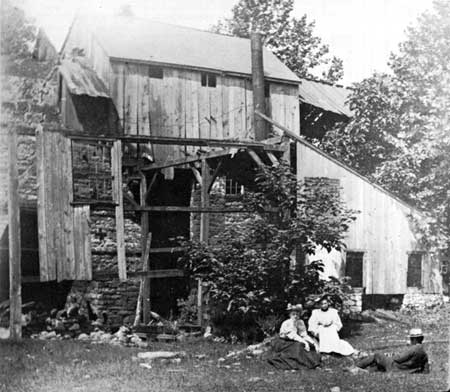|
HOPEWELL VILLAGE National Historic Site |
 |
Clement Brooke
Clement Brooke started work at Hopewell in 1804, when quite a young man, as assistant to his father. By 1816, he was actively managing the furnace. For the next 33 years, until 1849, he directed virtually every phase of Hopewell activity. These were the years of Hopewell's greatest prosperity. Recognizing that efficiency was the key to profitable operation of the furnace in a period when the tempo of business was increasing, he introduced many changes and undertook new construction. There was more construction activity during those 33 years than during the preceding 46 years or the 34 years that followed. In addition to extensive repairs to existing structures and buildings, he built new ones. In 1817, the cupola was built to make more and better finished castings. In the years following, several improvements were added to the blast machinery. The furnace was completely rebuilt in 1828, with increased capacity. Shaft mining was expanded at Hopewell and Jones' Mines and the latest hydraulic equipment installed.
Clement Brooke believed in promoting the efficiency of the workers by improving their conditions. He increased their wages and rewarded them for "perseverance"—sometimes with silver watches, as entries in the account books show. For his miners, who had been living in log cabins at the mine holes, he built stone houses. He promoted one of them, John Benson, to furnace clerk, noting that he was neat of hand, alert, and dependable. The exquisitely fine penmanship in the furnace books of this period, one of which is on display in the temporary museum came from his hand. John Benson later became an ironmaster in his own right at another furnace.
Drunkenness among the workers, a great problem at early ironworks, was radically reduced. Clement Brooke made his skilled workmen at least subscribe to the Temperance Advocate, probably paying for the subscription himself. For education of the children, he built a schoolhouse in 1836. (It stood just back of the tenant house which is nearest to Joanna Road, and was used until 1870.)
Indicative of Clement Brooke's wide interests is the number of newspapers and periodicals he subscribed to (as many as 14 in the 1840's), dealing with technology, farming, politics, religion, and temperance.
In 1849, he turned over active management of the furnace to his son-in-law, Dr. Charles M. Clingan. A few years later he retired to his farm, but he continued his keen interest in its affairs, as well as part-ownership, until his death in 1861. His connection with Hopewell Furnace spanned more than half a century, about one-half of its entire active history.
Dr. Clingan, who married Maria T. Brooke in 1843, began his association with the furnace shortly thereafter. The son of an ironmaster, he studied medicine in Philadelphia. But business was his main interest and he engaged in various enterprises in Philadelphia and Reading. Dr. Clingan managed Hopewell Furnace actively for about two decades, becoming co-owner with Edward S. Buckley following the death of Clement Brooke in 1861. He was an energetic man, handsome in appearance, and well-liked by the workmen. He died in 1875, in Philadelphia, last of the Hopewell ironmasters. The remaining partner, Buckley, carried on at Hopewell through his resident manager, Harker A. Long, until the furnace closed down permanently in 1883.

The Hopewell Furnace group as it appeared in 1896.
In the background from left to right are the furnace, bridge house, and
open-sided shed on furnace bank. In the foreground is the shell of the
cast house, the boarded portion to the right being the moulding
room.
Courtesy Chester County Historical Society.
After 1883, the woodland adjoining Hopewell Village continued to make good returns for several years, but the active days of cold-blast, charcoal-iron manufacture were over. Important technological changes in the industry had already begun to take place about 30 years before. The small, stone furnaces of Pennsylvania have given way to huge smelters towering 100 feet or more, with giant heating stoves, blowing engines delivering thousands of cubic feet of hot blast per minute, and a vast array of dust arresters, gas washers, and automatic ore- and coke-handling machinery. Water power has been superseded by steam and electric power; while coke as fuel has taken the place of charcoal, and also of anthracite, which was used to some extent after 1830. Hopewell Village is thus but a memory of a long and picturesque era in the iron industry.

|

| History | Links to the Past | National Park Service | Search | Contact |
|
Last Modified: Mon, Dec 2 2002 10:00:00 am PDT |

